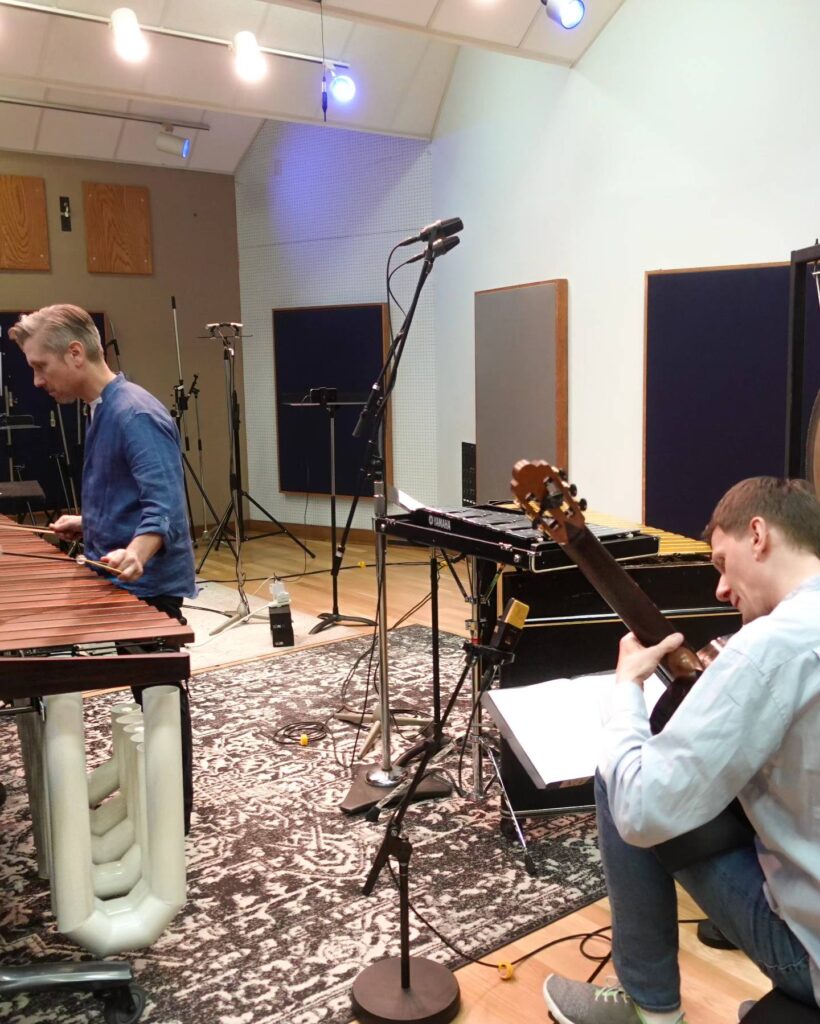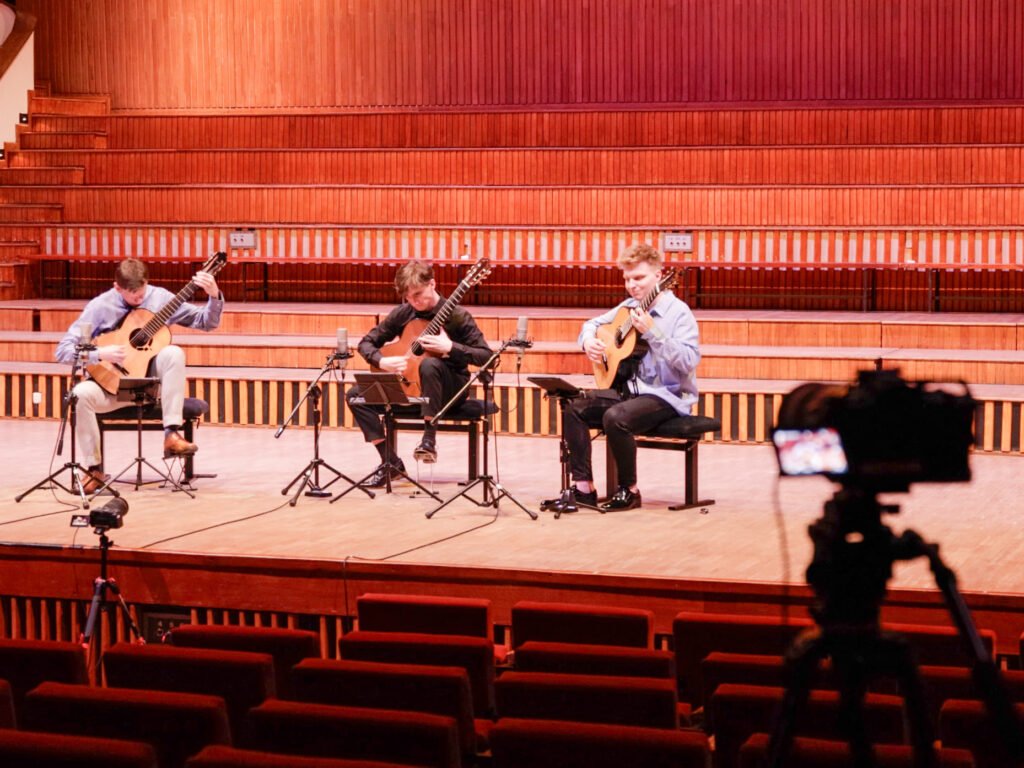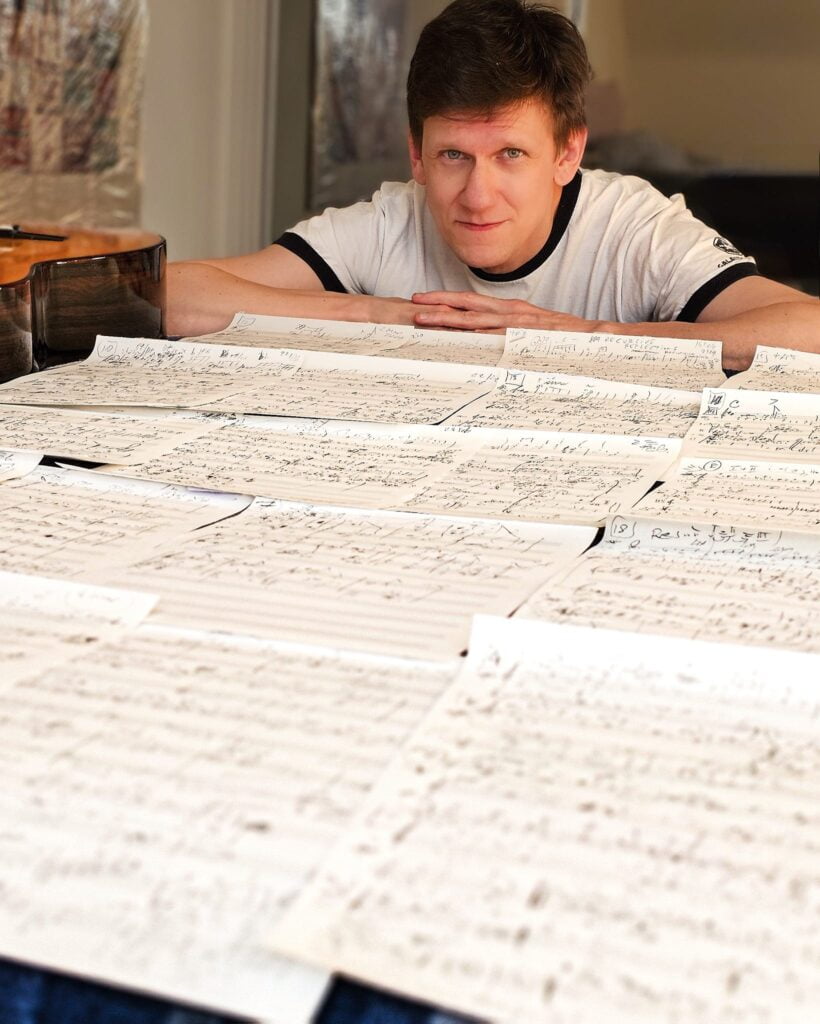New album with Thomas Burritt 'MUSIC FOR GUITAR & PERCUSSION’ will be out soon! Recorded at the recording studio of The University of Texas at Austin, TX, USA



guitarist and composer
New album with Thomas Burritt 'MUSIC FOR GUITAR & PERCUSSION’ will be out soon! Recorded at the recording studio of The University of Texas at Austin, TX, USA



’RECURSIVE REFLECTIONS’, has been recorded by Mateusz Kowalski, Andrzej Grygier and myself.
audio recording by: Daniela Rippel-Markiewicz , Franciszek Jakubiak, and Dr. hab. Ewa Lasocka of Uniwersytet Muzyczny Fryderyka Chopina, video footage and pictures by Mikołaj Szenfeld.




Recursive Reflections: 35 Variations with Fugue (for Guitar Trio) (2024)
The form of a guitar trio has always fascinated me, especially the sonic effects produced by three identical instruments. The balance, symmetry, and perhaps most importantly, the stereophonic and expansive sound that such instrumentation creates. The initial sketches for Recursive Reflections were made several years ago, already with the idea of a guitar trio in mind. This is one of those rare instances of a composer revisiting old sketches from the past.
Despite the undeniable sonic appeal of such an ensemble, original repertoire for guitar trio practically does not exist (compared to hundreds, or perhaps even thousands, of guitar duets and quartets).
The main inspiration for the musical architecture of Recursive Reflections came from four sets of variations, all with the same instrumentation (the piano as the composer’s instrument of interest), but entirely different in style, time of creation, and compositional material: J.S. Bach and his 30 Goldberg Variations, BWV 988; 14 variations on the theme ‘Enigma’ by Edward Elgar (in the solo piano version); 33 variations for piano, Op. 120 (on a theme by Antonio Diabelli), by Ludwig van Beethoven; and finally The 48 Variations for Two Pianos by John McGuire from 1976-1980.
It is worth noting from the outset that in this composition, I didn’t distinguish between guitar: one, two, and three, but rather divided them into central, left, and right guitar. I did this very consciously, guided within this compositional architecture by the most important factor shaping the entire trio – the aforementioned sonic aspect (stereophonic effect).
Recursive Reflections consist of 35 variations and a three-voice fugue. In Beethoven’s aforementioned variations, the 29th variation is written in the form of a fugue. In the case of Recursive Reflections, the fugue itself appears in its pure form as the penultimate part. The fugue form and the polyphony of the psalms are nods to Bach. However, the reminiscence (sketches of the theme) of the fugue appears throughout the variation form in a hidden manner (as in the case of the mysterious theme of the ’Enigma’ in Elgar’s variations). The theme appears in six scattered variations throughout the entire piece, in different modes, intensities, tonalities, and contexts. The fluidity between variations, the sonic element, post-minimalism, and ambient qualities are references to the aforementioned McGuire Variations.
The variations themselves are divided into five interwoven groups.
In terms of quantity, the first group (also the titular group) is ‘Recursive Reflection’, where the three instruments perform the same compositional material. However, this portion of the material is presented with very precisely planned delays. It’s a kind of recursive reflection (not in visual, physical, or mathematical form), but in musical form, in the form of sound.
The second group is ‘Mirror’. The central guitar serves as the compositional center (often in the form of an ostinato or an integral part). In this center, the neighboring guitars (left and right) musically reflect each other alternately, like in a mirror.
The third group is ‘Bells’. Here, all elements of the composition are subordinate to sonority – the classical effect of bells. Resonance, space, time, and the meditative character are significant in shaping the form of each variation.
The fourth group is ‘Psalm’. A short form serving as a purifying and reflective effect. Polyphonic, almost choral in its compositional material.
The fifth group is ‘Shadows’. In contrast to the previous groups, here the harmonic monolith is the entirety of the trio’s sound. None of the three parts is integral or stands out. The material of each part is different, yet each part complements and supplements its neighboring parts simultaneously.
Recursive Reflections are my personal variations on the sonority of three identical instruments, in this case, classical guitars. Despite the reminiscence of the fugue theme as an element integrating the entire form, it is not the theme but rather the stereophonic aspect that was the reason for the creation of the piece and the shaping factor.
I hope that Recursive Reflections will, at least to some extent; help rediscover the unique potential that a chamber ensemble composed of three classical guitars carries.
The piece is dedicated to my friend, the outstanding luthier and artist – Philip Woodfield.
Marek Pasieczny
(Leeds, United Kingdom, April 2024)
(in Polish)
Rekursywne Odbicia: 35 Wariacji i Fuga (na Trio Gitarowe) (2024)
Od zawsze fascynowała mnie forma tria gitarowego, zwłaszcza efekty sonorystyczne trzech takich samych instrumentów. Balans, symetria oraz, być może przede wszystkim, stereofoniczne i szerokie brzmienie, jakie daje takie instrumentarium. Pierwsze szkice do Recursive Reflections powstały kilka lat temu, już wtedy z myślą o trio gitarowym. To jeden z tych rzadkich przypadków kompozytorskiego powrotu do starych szkiców z przeszłości.
Mimo niezaprzeczalnej atrakcyjności brzmieniowej takiego składu, oryginalny repertuar na trio gitarowe praktycznie nie istnieje (w porównaniu do setek, a może nawet tysięcy duetów i kwartetów gitarowych).
Główną inspiracją muzycznej architektury Recursive Reflections były cztery formy wariacyjne, tej samej instrumentacji (fortepian jako instrument zainteresowania kompozytora), jednak zupełnie różne w stylu, czasie powstania i samym materiale kompozytorskim: J.S. Bach i jego 30 wariacji Goldbergowskich, BWV 988; 14 wariacji z tematem „Enigma” Edwarda Elgara (w wersji na fortepian solo); 33 wariacje na fortepian, Op. 120 (na temat walca Antonio Diabellego), Ludwiga van Beethovena oraz 48 wariacji na dwa fortepiany Johna McGuire’a z lat 1976-1980.
Warto na samym początku zaznaczyć, że w tej kompozycji nie rozróżniłem gitar na pierwszą, drugą i trzecią, a podzieliłem je na gitarę środkową, lewą i prawą. Zrobiłem to bardzo świadomie, kierując się w ramach tej kompozytorskiej architektury, najważniejszym czynnikiem kształtującym całe trio – przywołanym już aspektem sonorystycznym (efektem stereofonii).
Recursive Reflections składają się z 35 wariacji oraz trzygłosowej fugi. W wspomnianych wariacjach Beethovenowskich, wariacja 29-ta napisana jest właśnie w formie fugi. W przypadku Recursive Reflections, sama fuga pojawia się w czystej formie jako część przedostatnia. Forma fugi oraz polifoniczność psalmów to nawiązanie do Bacha. Jednak reminiscencja (szkice tematu) fugi pojawiają się na wskroś formy wariacyjnej w ukryty sposób (tak jak w przypadku tajemniczego tematu ‘Enigmy’ w wariacjach Elgar’a). Temat występuje w sześciu rozproszonych na przestrzeni całego utworu, wariacjach w różych trybach, o różym natężniu, w różych tonacjach oraz w różym kontekscie. Płynność pomiędzy wariacjami, element sonorystyczny, post-minimalizm i ambient to odwołanie do przywołanych Wariacji McGuire’a.
Same wariacje występują w pięciu przemieszanych ze sobą grupach.
Pod względem liczebności, pierwsza grupa (zarazem grupa tytułowa) to Recursive Reflection (rekursywne odbicie). Trzy instrumenty wykonują ten sam materiał kompozytorski. Jednak ten potrójnie zaprezentowany materiał zostaje pokazany z bardzo dokładnie zaplanowanym opóźnieniem. To swego rodzaju rekursywne odbicie (nie w formie wizualnej, fizycznej czy matematycznej ), ale w formie muzycznej, w formie dźwięku.
Druga grupa to Mirror (lustro). Gitara środkowa stanowi kompozytorskie centrum (często w formie ostinato lub integralnej partii). W owym centrum, naprzemiennie jak w lustrze: muzycznie odbijają się gitary sąsiadujące (lewa i prawa).
Grupa trzecia to Bells (dzwony). Tu wszystkie elementy kompozycji podporządkowane są sonorystyce – klasycznemu efektowi dzwonów. Wybrzmienie, przestrzeń, czas, charakter medytacji ma tu znaczenie kształtujące formę danej wariacji.
Czwarta grupa to Psalm. Krótka forma pełniąca efekt oczyszczający i refleksyjny. Polifoniczna, wręcz w swoim charakterze materiału kompozytorskiego – chóralna.
Grupa piąta, to Shadows (cienie). W opozycji do poprzednich grup. Jedyna grupa, w której harmonicznym monolitem jest całokształt brzmienia tria. Tu żadna z trzech partii nie jest integralna, czy wyróżniająca się. Materiał każdej z nich jest inny, równocześnie zarazem każda partia z osobna dopełnia i uzupełnia partie jej sąsiadujące.
Recursive Reflections to moje osobiste wariacje na temat sonorystyki trzech takich samych instrumentów, w tym przypadku gitar klasycznych. Mimo reminiscencji tematu fugi jako elementu integrującego całą formę, to nie temat, a właśnie aspekt stereofoniczny był powodem powstania utworu oraz czynnikiem jego kształtującym.
Mam nadzieję, że Recursive Reflections pomogą choć w małym stopniu odkryć na nowo unikalny potencjał, jaki niesie ze sobą zespół kameralny złożony z trzech gitar klasycznych.
Utwór dedykuję mojemu przyjacielowi, wybitnemu lutnikowi i artyście – Philipowi Woodfieldowi.
Marek Pasieczny
(Leeds,Wielka Brytania, kwiecień, 2024)
RECURSIVE REFLECTIONS: 35 Variations with Fugue, for a Guitar Trio, has been world-premiered during The 2nd Warsaw Guitar Conference at the Auditorium Maximum, Warsaw University (in collaboration with UMFC Fryderyk Chopin University). This over 50-minute-long composition was premiered by Marek Pasieczny, Mateusz Kowalski and Andrzej Grygier



Dumnie wspierane przez WordPressa | Motyw: Baskerville 2. Autor motywu: Anders Noren.